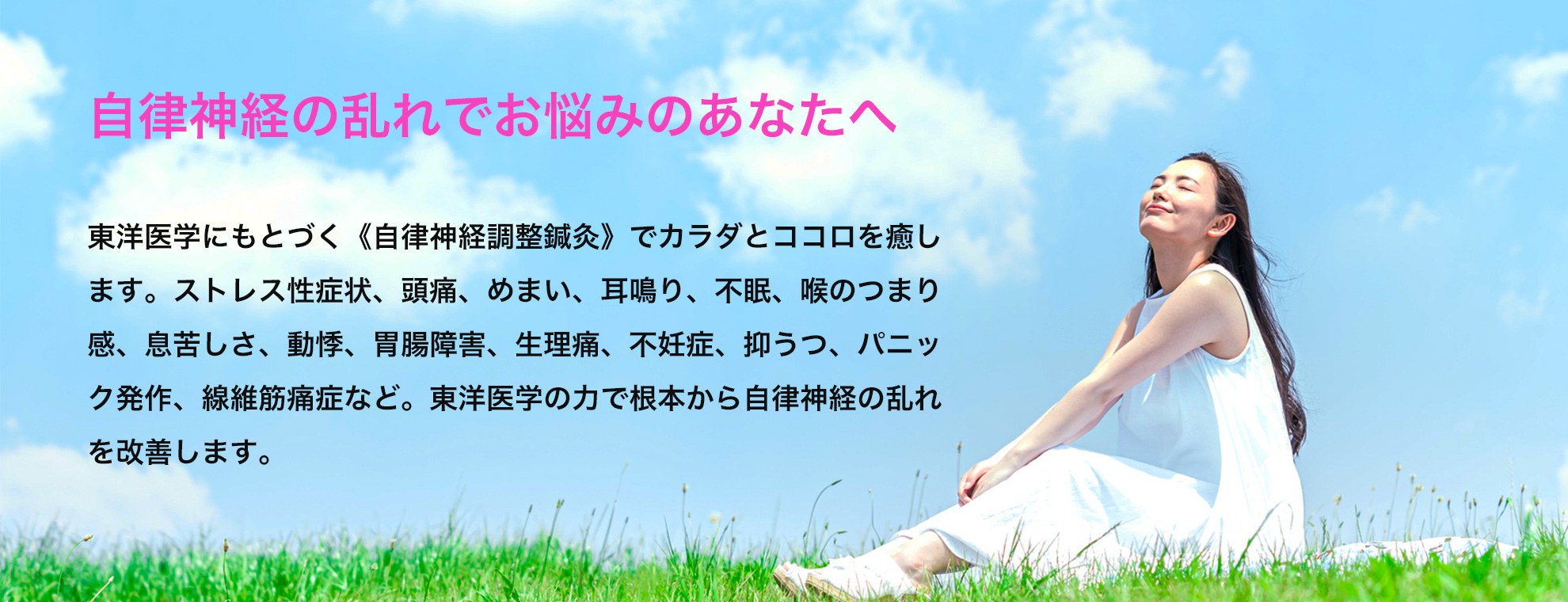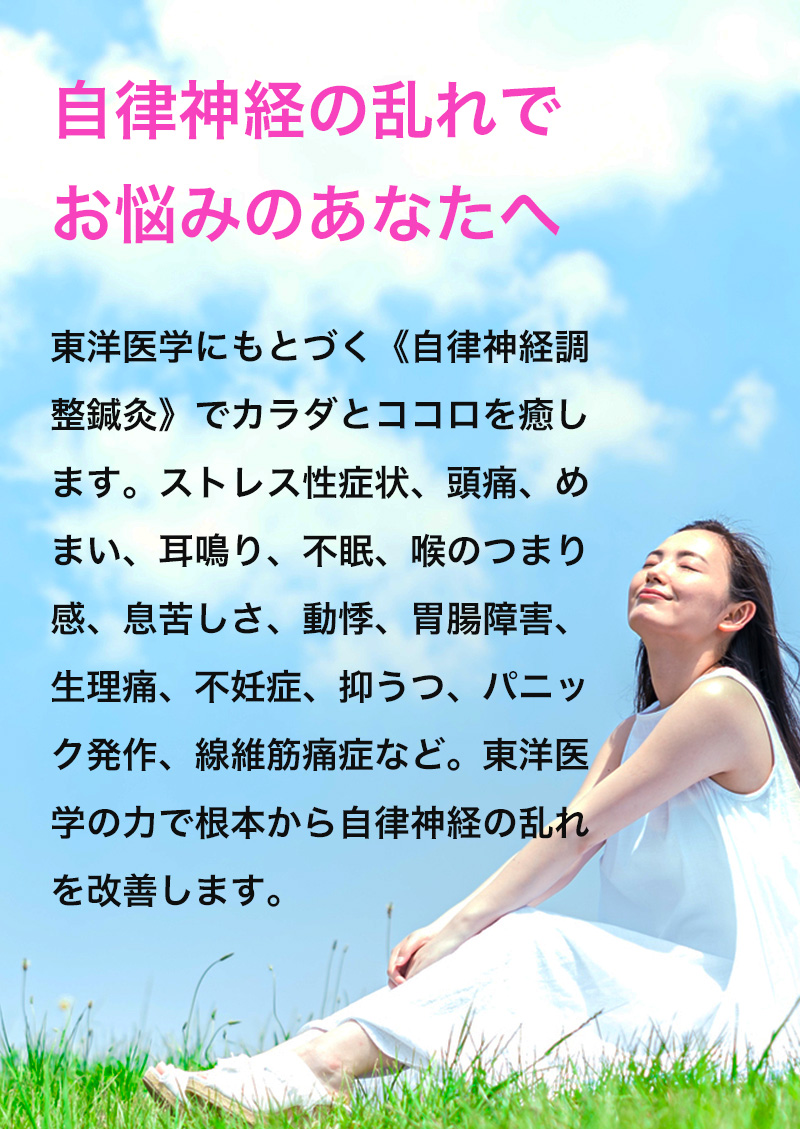稲森 英彦 Hidehiko INAMORI
プラナ松戸治療室代表
【略歴】
東京都生まれ。慶應義塾大学文学部卒。
1998年に鍼灸師資格を取得。心療内科クリニックに勤務し、東洋診療部門を立ち上げる。
2005年に自律神経系・心療内科系鍼灸院のプラナ松戸治療室を開設。
現在(2025年)臨床歴27年。



ストレスによる息苦しさ、めまい、喉のつまり感、動悸、吐き気、不眠、頭痛、首肩腰痛、慢性疲労、不妊、目の不調などに。全身のバランスを整えて自律神経の乱れを癒します。
詳細はコチラ
頭皮の特定の機能局在領域(脳の各機能に対応する部位)やツボに細い鍼を優しく刺激することで、脳機能の活性化、神経伝達の改善、自律神経のバランス調整、精神的な安定を目指す施術です。
詳細はコチラ
息苦しさ、不眠、動悸、うつ症状、痛み、めまいなど、幅広い症状に鍼灸で改善をもたらした症例集です。自律神経の調整から、体調不良まで、心身の調和を取り戻す症例をご紹介します。
詳細はコチラご予約、ご相談、ご質問などはこちらのフォームをご利用下さい。
プラナ松戸治療室です。
今年も多くの方々に当治療室をご利用いただきまして
誠にありがとうございました。
本日で年内の診療は終了いたしました。
新年は1/7(火)から診療を開始いたします。
なお1/7(火)のご予約はすでに満枠のため、
1/8(水)からのご予約を承ります。
来年も何卒よろしくお願い申し上げます。
2年前から頻尿の症状が現れる。昼間は約30分ごとにトイレに行きたくなり、夜間も尿意で数回目が覚める状態が続いていた。泌尿器科を受診したものの、症状は改善しなかった。
奥様の紹介で当鍼灸院を訪れることとなった。
脊椎鍼灸療法の比較触診を行ったところ、以下の異常が見つかった:
・胸椎3番・4番:呼吸器と関連のある椎骨
・腰椎5番:呼吸器および膀胱と関連の深い椎骨
・腰椎3番:泌尿器と強く関連する椎骨
今年の梅雨から夏にかけて湿気と熱気が厳しく、多くの人々が呼吸器に負担を抱えていた状況から、呼吸器への負担が泌尿器に影響を及ぼした可能性が高いと考えた。このため、初診では主に呼吸器を整える治療を実施した。
初診後、2日ほどは日中のトイレの間隔が長くなったとの報告があった。診察の結果、呼吸器系の椎骨はほぼ整っていたものの、腰椎3番に強い異常が残っていることが判明した。
患者に詳しく尋ねたところ、職業が運送業のドライバーであり、30kgほどの荷物を担ぐ仕事をしていることが判明。これにより、2年前に頻尿が発症した原因が、腰椎3番への過度な負荷である可能性が高いと考えられた。
2診目では、腰椎3番を中心に整える脊椎鍼灸療法を実施。
2診目の治療後、夜間の尿意で目覚めることがなくなり、日中のトイレの間隔も90分ほどに伸びたとの報告があった。また、紹介者である奥様からも「頻尿が大きく改善した」と喜びの声をいただいた。
このケースでは、仕事で重い荷物を担ぐことにより、泌尿器と関係の深い腰椎3番に負荷がかかり、頻尿が引き起こされたと考えられる。また、酷暑の湿気や熱気による呼吸器への負担が腰椎5番を介して泌尿器にも影響を及ぼし、症状改善を妨げていた可能性がある。
本治療により、呼吸器と腰椎の調整を行った結果、頻尿が改善されたと推測される。
The patient started experiencing symptoms of frequent urination two years ago. During the day, he needed to use the restroom approximately every 30 minutes, and at night, he woke up several times due to the urge to urinate. Despite consulting a urologist, his symptoms did not improve.
Following a recommendation from his wife, he visited our acupuncture and moxibustion clinic.
Through comparative palpation during spinal acupuncture therapy, the following abnormalities were identified:
・Thoracic Vertebrae 3 and 4: Vertebrae associated with respiratory functions.
・Lumbar Vertebra 5: Related to both respiratory and bladder functions.
・Lumbar Vertebra 3: Strongly linked to urinary functions.
Given that this year’s rainy season and summer brought high humidity and heat, which strained the respiratory systems of many individuals, it was hypothesized that respiratory burden might have affected urinary functions. Thus, the initial treatment focused on balancing the respiratory system.
The patient reported that for two days after the first treatment, the intervals between restroom visits during the day lengthened. Examination revealed that while the vertebrae related to respiratory functions were almost aligned, a strong abnormality persisted in Lumbar Vertebra 3.
Upon further inquiry, the patient disclosed that he worked as a truck driver and frequently carried loads weighing approximately 30 kg. This information led to the conclusion that excessive strain on Lumbar Vertebra 3 from his job was likely the root cause of his frequent urination.
The second treatment focused on correcting Lumbar Vertebra 3 through spinal acupuncture therapy.
After the second treatment, the patient reported no longer waking up at night due to the urge to urinate. Additionally, the intervals between restroom visits during the day extended to about 90 minutes. His wife, who had referred him to the clinic, also expressed delight, noting significant improvement in his symptoms.
This case suggests that frequent urination was triggered by strain on Lumbar Vertebra 3, closely linked to urinary functions, due to the physical demands of the patient’s job. Furthermore, the burden on the respiratory system caused by extreme humidity and heat may have indirectly impacted urinary functions via Lumbar Vertebra 5, complicating symptom improvement.
By addressing both respiratory and lumbar issues through treatment, the patient’s symptoms improved significantly.
40代の男性。昨年の春頃から両ふくらはぎに違和感を感じ始め、徐々に悪化し、歩行が難しくなるほどの状態になってしまいました。
その後、筋膜性疼痛に特化した鍼灸院でトリガーポイント鍼治療を受け、痛みが改善し、歩けるようにはなりましたが、ふくらはぎの硬さやツッパリ感といった違和感が残り、治療を継続しても完全には解消しませんでした。
そのような中、当治療室を利用している兄弟の勧めで、当治療室にお越しになりました。
この方は、運転手として働いており、神経を酷使する環境に加えて、過去に下腿の骨折を経験されています。
当治療室の脊椎鍼灸療法の考え方では、下腿三頭筋やアキレス腱は脳の影響を受けやすく、過度な思考や目の酷使による神経系の負担が筋肉の緊張を引き起こすと考えています。
今回のケースでは、運転手として目を酷使し、神経系に負荷がかかり続けていることが、ふくらはぎの違和感改善の妨げとなっていると考えました。
実際に体を観察すると、神経系に負担がかかっている様子が確認できました。
そこで、脊椎鍼灸療法で神経系を整え、あわせてふくらはぎの筋膜に対する処置を行ったところ、初回の施術で違和感が大幅に改善し、2回目の施術後にはほとんどの違和感が消失しました。
治療後の説明時に神経系への負担についてお伝えしたところ、この方は以前にうつ病を経験されていたことがわかりました。うつ病を経験した方は神経系が乱れやすい傾向があり、今回のふくらはぎの違和感が改善しにくかった一因であった可能性も考えられました。
A man in his 40s began experiencing discomfort in both calves around the spring of last year. The symptoms gradually worsened to the point where walking became extremely difficult.
He then underwent trigger point acupuncture therapy at a clinic specializing in myofascial pain, which alleviated the pain and enabled him to walk again. However, the stiffness and tightness in his calves persisted as residual discomfort, and even with continued treatment, these symptoms did not fully resolve.
Amid these circumstances, he decided to visit our clinic upon the recommendation of a sibling who is also a client here.
This individual works as a driver, a profession that places considerable strain on the nervous system. Additionally, he has a history of a leg fracture in his past.
From the perspective of our spinal acupuncture therapy approach, the gastrocnemius muscles and Achilles tendons are highly influenced by brain activity. We believe that excessive mental strain or prolonged eye strain can place a burden on the nervous system, leading to muscle tension.
In this case, his constant eye strain and nervous system fatigue as a driver appeared to be impeding the improvement of the discomfort in his calves.
Upon examination, we observed signs of significant strain on his nervous system.
We administered spinal acupuncture therapy to regulate his nervous system, along with specific treatments targeting the myofascia in his calves. This resulted in a marked improvement in his symptoms after the first session, and by the second session, most of the discomfort had disappeared.
During the post-treatment consultation, we discussed the impact of nervous system strain, and he revealed that he had a history of depression. People with a history of depression often have a predisposition to nervous system imbalances, which may have contributed to the difficulty in resolving the discomfort in his calves.